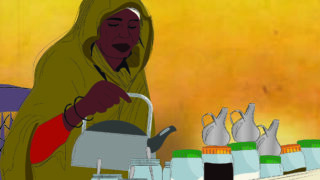
This publication has benefited from the support of the Rosa Luxemburg Foundation. This text may be reproduced in part or in full, provided the source is acknowledged.
Scientific and academic milieus in Sudan have started to highlight climate change issues, albeit at a much slower rate than that by which global realities have been unfolding. Although a considerable number of studies, reports, and surveys have covered Sudan and shown clear indications of (the dire) climate change effects in every region, the authorities don’t seem to be interested in the question of climate. At best, the state treats climate change as if it were an improbable event, while none of the politicians have even shown even the slightest interest or vision as regards this issue.
As Sudan continues to be embroiled in political conflict and economic decline, to think about climate change is considered a luxury, both politically and economically. This feeds into the prevalent perception, which isn’t limited to Sudan, that climate change means a mere rise in temperature, a decline in precipitation, and ice melting. In reality, however, climate change directly affects human lives, through drought, food scarcity, and everything that these conditions may imply…
According to the United Nations, Earth’s temperature has risen by 1.1°C since the late nineteenth century. The years 2011 to 2020 were the warmest on record. This is mainly the result of burning fossil fuels (coal, petrol, and gas), using gasoline to drive cars and coal to heat up buildings (or for other uses in some countries), which all result in greenhouse gas emissions (carbon dioxide and methane) that, in turn, cause climate change. Clearing the lands of plants, trees, and deforestation also results in CO2 emissions. According to the UN, landfills are considered a major source for methane emissions. Energy production and consumption, industry, transportation, agriculture, and land use are considered some of the major emitters.
The least developed are the most affected
The United Nations classifies Sudan as one of the least developed countries, and as such, it is affected by climate change rather than affecting it. Sudan isn’t an industrial country, which means that it has a low level of emissions, and yet, it is one of the countries that suffer most from climate change. Studies show that African countries are most affected due to their low adaptive capacity.
A COP26 report, issued following the Glasgow talks in November 2021, warned that the 65 countries most vulnerable to climate change around the world, topped by Sudan, will experience a 20% drop in their GDP by 2050 and a 64% drop by 2100 should the temperature rise by 2.9°C. The study, conducted by Christian Aid, noted that even if the temperature rise was maintained at 1.5°C, which is the most ambitious of objectives placed in the Paris Climate Agreement (2015), the GDP of these countries would still decline by 13% by 2050 and by 33% by the end of the current century.
In recent years, the climate in Sudan has been different than what it was in earlier years. Climate experts focus on three main axes to measure climate change in a given region: rainfall, temperature, and sea-level rise. Dr Ismail Al-Jazuli, energy, environment, and climate change expert, says that during the past ten years, studies and research have noted intense fluctuations in rainfall, and indicated that the autumn seasons themselves have become overlapping and enmeshed with other seasons. As a result, the agricultural process that had been stable for about a century, thanks to a steady distribution of rainfall throughout autumn, has now become muddled. According to Al-Jazuli, however, the climate has become more extreme, which directly affects agriculture, as rainwater distribution throughout autumn is what farmers base their plans upon.
In the north of Sudan, for instance, Al-Jazuli says that a study has been conducted about the wheat harvest, noting that such a disparity has actively affected the quality and quantity of crops, which have both notably declined.
Burning fossil fuels (coal, petrol, and gas) produces greenhouse gas emissions that, in turn, cause climate change, as does using gasoline to drive cars and coal to heat up buildings. Clearing the lands of plants, trees, and deforestation also results in CO2 emissions. Landfills are equally considered a major source for methane emissions.
Many experts think that these changes in North Sudan have probably taken place because of the Merowe Dam that was constructed in 2009. Date producers also complain that the quality of their crops has degraded due to rising levels of humidity. It is important to note, however, that there are no scientific studies about the effect of dams in Sudan.
In an academic paper which he presented in October 2020, Al-Jazuli notes that the temperature mean in Sudan has notably risen and that, if the world doesn’t seriously address climate change and work hard to limit its effects, it is expected that temperatures would begin to notably rise from 1.5°C to 3.1°C in August 2060.
Generally speaking, Sudan’s climate is hot most of the year, with seasonal rainfall decreasing as we move up north. Rain falls in larger amounts in the southern parts of the country, reaching an annual rate of 692 mm in Al-Damazin region, which borders Ethiopia, an area where rain falls for eight months a year. According to the 2020 official report, The State of the Environment and Outlook in Sudan (1) , the Sudan Meteorological Authority data notes that rainfall was delayed during the period (1981-2016). The same data indicates that droughts have become more frequent and that the overall temperature mean has become extremely high; this renders the country dry and barren, with dropping rates of rainfall. Temperatures peak in May and June, where the temperature mean reaches 41°C. The data showed, however, that the temperature could reach 47°C.
North Darfur has experienced its driest year since 1972 – which has clearly affected its agricultural and livestock production. Crops failed by around 40% on average, and, according to the National Adaptation Plan, it is expected that crops would fail by an average of 70% by 2050.
The coastal Red Sea state is susceptible to sea-level rises and the adverse ramifications of sea surface temperature variations and changes in marine biodiversity. In Al-Qadarif, rainfall levels have affected the state’s agroeconomic sector, leading to a 25% decline in corn production (a staple crop) between 1981 and 2008. Health-wise, the eastern part of the country will experience bigger outbreaks of dengue fever and malaria.
Although Sudan is, to a large extent, a desert and semi-desert country, natural resources form the economic backbone of Sudan. According to the World Bank data, the agricultural sector contributes to around 30-35% of the country’s GDP, while 65% of the population relies on agriculture for their livelihood. According to the Food and Agriculture Organization of the United Nations in 2018, agriculture provides jobs for around 50% of the labour force.
The State of the Environment and Outlook Report states that the biggest effect of climate change in Sudan is manifest in the deteriorating food production. Therefore, the efforts to adapt to climate change and limit its effects across the country would include transitioning into improved drought-resistant crops and livestock breeds, developing green belts of Arabic gum, and transitioning into sources of renewable energy. Likewise, while the country’s exposure to long hours of sunshine would be sufficient to use for generating energy, Sudan relies to a large extent on fossil fuel to generate energy, which exposes people to a host of contaminants. Official data notes that 56% of energy supply in Sudan is derived from the biomass (wood, coal, agricultural residues, and animal waste), 39% is derived from petrol (gasoline, diesel, and heavy oils), and 5% from hydroelectricity.
Major changes across Sudan
As deteriorating food production is one of the most prominent dangers of climate change in Sudan, water, grazelands, and agriculture will all clearly reflect the extent of this change, where the majority of the population practices agriculture and animal farming.
Sudan’s area extends over 1.88 million km2, and arable lands form around a third of the country’s overall area. The entirety of arable lands makes up no more than 21%, while 35% of Sudan’s area is grasslands. In many areas, farming and agro-pastoral communities have peacefully coexisted, but climate change now poses a major threat, as many negative social changes are expected to take place as a result of sharing limited resources.
Notably, most armed conflicts in Sudan were sparked by the struggle over natural resources. In Darfur, for instance, the relationship between agro-pastoral communities have continuously remained prone to clashes. Experts, therefore, carefully examine conflict-ridden areas as those are multiple times more susceptible to the dangerous consequences of climate change than other areas.
The Darfur region is made up of 5 main states: North Darfur, with its semi-desert climate, West and Central Darfur – which is a low-rainfall savanna region, and South and East Darfur, which are high-rainfall savannas. Rainfall in Darfur varies across its regions. According to the National Adaptation Plan, such patterns have intensified in recent years, where the northern areas of Darfur have seen their driest years since 1972 – which has clearly affected its agricultural and livestock production. Crops failed by around 40% on average, and, according to the National Adaptation Plan, it is expected that crops would fail by an average of 70% by 2050.
As for the eastern part of the country, it has a desert and semi-desert climate and a low-rainfall savanna. Its economy is based on a combination of traditional farming and rain-fed mechanised farming, alongside animal husbandry and commercial activity in the coastal area, which includes a number of ports. That part has been undergoing increased climate variability, a decline in rainfall, and a rise in temperature. According to the official reports upon which the National Adaption Plan is based, these changes were unevenly distributed throughout the three states. Kassala State is considered most susceptible to significant variability in precipitation and to temperature increments. On the other hand, the Red Sea State (a coastal state) is susceptible to sea-level rises and the adverse ramifications of sea surface temperature variations and changes in marine biodiversity.
In the River Nile state, the rise in temperature, floods, and drought are considered constant threats to health, where water-borne diseases make up 80% of observed diseases, such as malaria, giardiasis, cholera, dysentery, and bilharzia.
The White Nile state contains around 8 million heads of sheep, goats, and cattle. The National Adaptation Plan report categorises the state as one of the most vulnerable in Sudan, as it has been considerably affected by climate change, with droughts, floods, temperature rises, declining annual rainfall, and increased climate variability.
In Al-Qadarif, rainfall levels have indeed affected the state’s agroeconomic sector, noting that rain-fed mechanised agriculture in Al-Qadarif comprises 90% of agricultural activity. Reports have noted a growing decline in corn production (a staple crop) between 1981 and 2008 at a rate of 25%. Health-wise, as the temperature rises, the eastern part of the country is expected to experience bigger outbreaks of dengue fever and malaria, which are diseases that already exist in Kassala.
In the central part of the country, with its Saharan climate, considerable temperature rises were noted during the winters of 1994-2005, which shortens the winter agricultural season and, subsequently affects crop yields. In the meantime, increasing wind speeds and shifting sand dunes have also been affecting (the limited number of) cultivated land by clogging irrigation canals.
In the River Nile state, the rise in temperature, floods, and drought are considered constant threats to health, where water-borne diseases make up 80% of observed diseases, like malaria, giardiasis, cholera, dysentery, and bilharzia.
New climate changes have appeared in Sudan, including in the River Nile state, where traditional gold-mining is commonly practiced. As environmental requirements are lacking and traditional activity is left unmonitored, the potential contamination of spring waters with cyanide is yet another new threat to consider. This has in fact happened in August 2022, where these substances leaked into spring waters during the last rain season.
Animal husbandry in these areas is considered the second major source of income, and yet rangeland productivity has been quickly declining due to the rise in temperature, recurrent droughts, increasing wind speeds, and overgrazing.
In the northern state bordering Egypt, the National Adaptation Plan (2) notes the emergence of new plant diseases due to climate change, like palm tree diseases in Al-Ghaba area. The report also notes that new diseases, such as scabies, which hadn’t existed in the state before, have likewise emerged.
Climate Change in Algeria and its Impacts
05-11-2022
Lebanon: Temperature Rises and Risks Multiply
24-11-2022
Furthermore, in Al-Jazirah state, which contains one of the largest farming operations in Sudan and one of the largest irrigation projects in the world, Al-Jazirah Scheme, with an area of 2 million feddans, climate variability is expected to pose serious threats. The affected areas would include the water sector, irrigated and rain-fed farming, forests, and rangelands. Rainfall, the Nile River, and groundwater are considered the primary water sources in Al-Jazirah State. Considering the substantial climate variability, these sources are vulnerable, where rain and groundwater provide 80% of local water supplies.
The Blue Nile State, which is located in the eastern part of the country, is a high-rainfall savanna with declining precipitation over the past decade (450-500 mm). During the same period, the state lived through cycles of floods and drought and experienced temperature rises and increasing wind speeds. The assessment of vulnerability to climate change has shown that the most affected city was Al-Damazin, Al-Roseires, and Al-Tadamun, which are the biggest of the Blue Nile cities. They were affected by floods, temperature rise, and cycles of drought. Climate change is equally a threat to the state’s agro-economy, which, in turn, threatens food security.
Although Sudan is, to a large extent, a desert and semi-desert country, natural resources form the economic backbone of the country. According to the World Bank data of 2016, the agricultural sector contributes to around 30-35% of the country’s GDP, while 65% of the population relies on agriculture for their livelihood. According to the Food and Agriculture Organization of the United Nations in 2018, agriculture provides jobs for around 50% of the labour force.
In many areas, farming and agro-pastoral communities have peacefully coexisted, but climate change now poses a major threat, as many negative social changes are expected to take place as a result of sharing limited resources. It is important to note that most armed conflicts in Sudan have originally erupted over natural resources.
The entire area of the White Nile borders South Sudan and reaches around 40 thousand square kilometres. It is where 70% of the population live off of traditional rain-fed farming and animal husbandry. The state contains around 8 million heads of sheep, goats, and cattle. The National Adaptation Plan report categorises the White Nile state as one of the most vulnerable in Sudan, as it has been considerably affected by climate change, with droughts, floods, temperature rises, declining annual rainfall, and a growing climate variability. Overall, climate change has affected water availability, agricultural potential - with increased frequencies of drought, dust storms, as well as floods. The report notes that non-climatic drivers of change have worsened these climate trends, like a reduction in the vegetation cover as a result of overgrazing and mismanagement of water resources.
The challenge ahead
Contrary to common understanding, climate change in Sudan will not spare any region, including those with a savanna climate. Food security remains the main concern in the coming years. Climate adaptation studies and plans have mapped out extremely clear preventive measures to protect the natural resources threatened by climate change, especially water (the annual per capita share of water is around 700 cubic metres, a much smaller number than the water scarcity threshold of 1000 cubic metres per capita). In Sudan, access to potable water and sanitation services is generally low, where only 70% of the urban population and 63.5% of rural areas have access to safe drinking water. Likewise, access to sanitation has an average of 39.5% (57% in urban areas and 22% only in rural areas). Forests are yet another endangered resource, as the UN Global Forest Resources Inventory indicates that forest cover in Sudan has fallen from 40% of the country’s area in the 1950s to 27% in the early 2000s. Public health issues, on the other hand, seem to be missing from the many studies conducted on climate change. Perhaps the biggest threat, however, is the increasing population growth in the country. According to the 2008 census, Sudan’s population of 44.4 million is expected to reach 57.3 million by 2030.
The content of this publication is the sole responsibility of Assafir Al-Arabi and Rosa Luxemburg Foundation cannot accept any liability for it.
Translated from Arabic by Yasmine Haj
Published in Assafir Al-Arabi on 20/10/2022
1- The State of the Environment and Outlook in Sudan 2020
2- The National Adaptation Plan https://bit.ly/3EUBzz4






